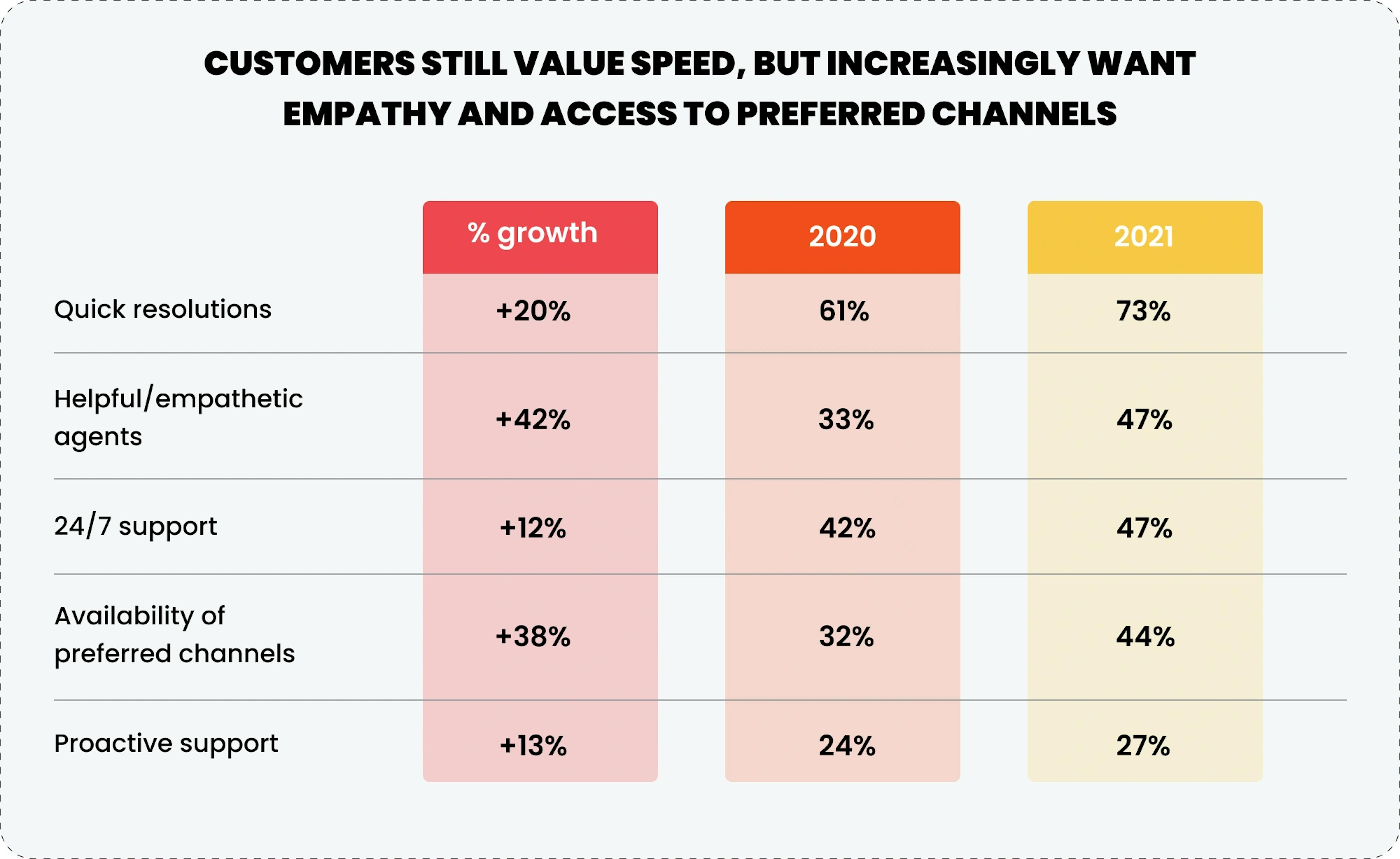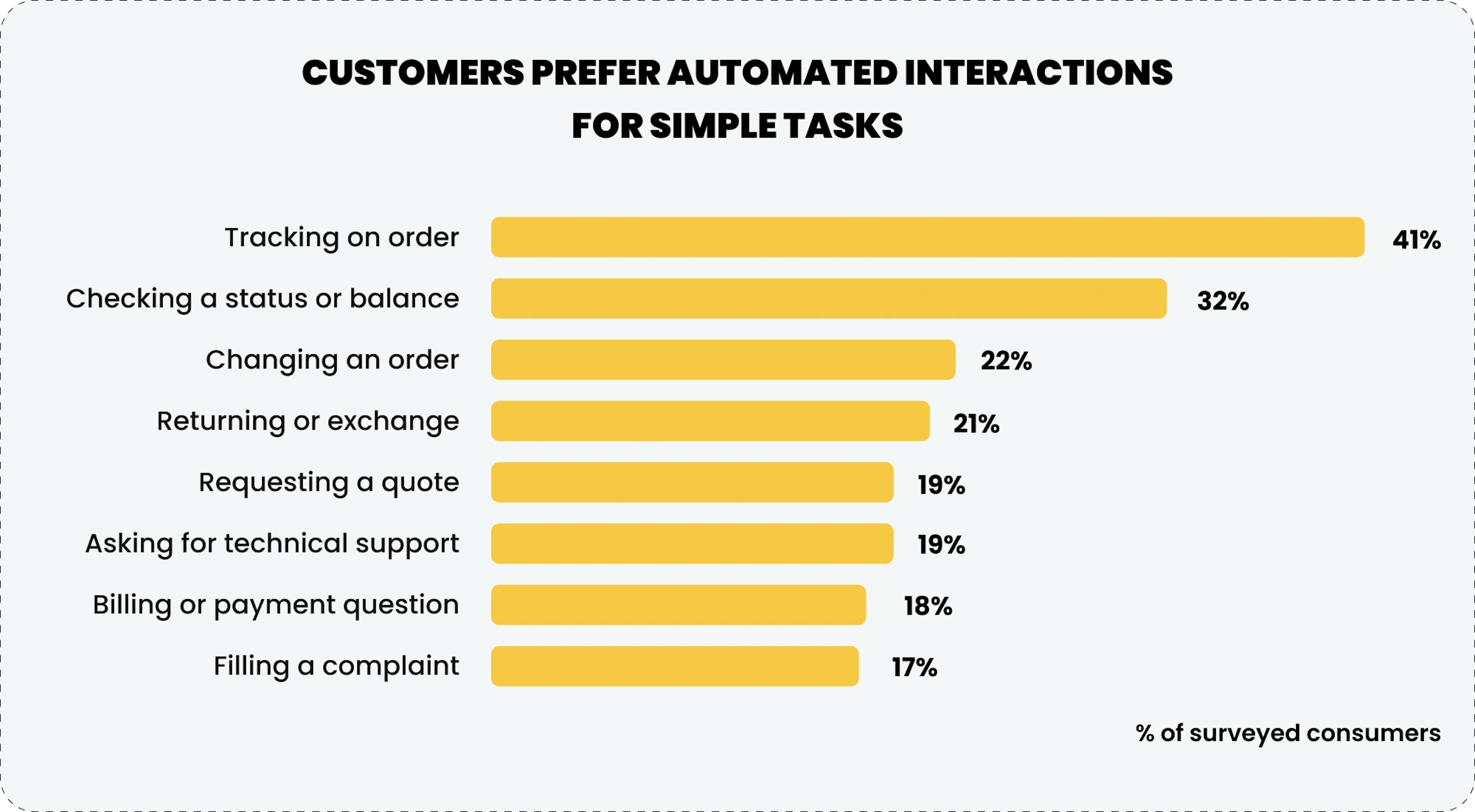Today, technology is rapidly permeating all areas of our lives, and automation is becoming an integral part of customer service processes. From intelligent chatbots to artificial intelligence systems, the evolution of how companies and their customers interact is undergoing significant change.
Automated customer service has advanced with improved voice recognition, enhanced AI for better feedback interpretation, and evolved chatbots directly addressing queries. This shift in functionality transforms automation from issue deflection to a personalized and efficient option for customer assistance.
What is automated customer service
Automated customer service utilizes technology like AI-powered chatbots rather than human assistance. It addresses recurring, straightforward inquiries, offers status updates, or assists in locating specific resources.
More and more machine learning bots guide customers by sharing links to relevant resources, such as knowledge base articles or FAQs. They can efficiently direct customer queries to the most suitable team and even provide responses to questions like, "How can I add more users?" or "How do I fix a problem?".
After introducing chatbots into their work, some companies reported that automating specific processes enhances the efficiency of customer service organizations. Approximately 88% of customers anticipate automated self-service when engaging with a business.
Customer service automation has proven impactful, yielding a 30% decrease in service costs, a 39% increase in customer satisfaction, and a remarkable 14-fold surge in sales.
How does automated service work
Imagine a customer facing an issue with an electronic product they purchased from your company. The device won't turn on. Automated customer service can guide them through a resolution:
- The customer visits your website and navigates to the support page.
- An AI chatbot greets them, asking them to describe the problem.
- Recognizing keywords like "won't turn on," the chatbot directs the customer to a relevant knowledge base article.
- The article guides them to check for a plastic tab in the battery slot. They find it, remove the tab, and the device starts working.
Automated customer service ensures a quick and efficient solution to issues in this seamless resolution process. This dedication to user-friendly support is just one way you can prioritize experience. Now, let's explore how Mad Devs has successfully integrated automated assistance to enhance customer satisfaction and streamline issue resolution.
Recently, our developers worked on a chatbot for an online platform that provides information and reviews about technology companies, digital agencies, and information technology service providers.
As part of this project, it was necessary to create a chatbot to assist site visitors in selecting a service provider and answering questions related to the site's operation. The working principle of the chatbot is as follows:
- To initiate interaction with the chatbot, the visitor must click on the "Let's Chat" button, after which the dialogue begins.
- The visitor needs to submit a request. Afterward, the bot will provide a solution.
- If the solution is deemed inappropriate or too broad, the visitor may ask to shorten the answer. The bot can pose clarifying questions and propose several options for addressing the request.
OpenAI works under the hood of the chatbot, assisting in conducting a dialogue. The chatbot not only processes individual keywords but also analyzes the context and structure of sentences, considering the user's previous statements. This allows it to understand queries more accurately and create more consistent and meaningful responses. Therefore, this approach makes interaction with a chatbot more natural and productive, elevating customer service to the next level.
Comprehensive project discovery services
Using the most popular trend and following it can be helpful for you and your company. You can choose the leading and expensive technologies and attract specialists to their development and implementation but not get the expected result. Conducting a comprehensive analysis is crucial, as automating custom services without understanding their intricacies and purposes may fall short. We recommend doing a comprehensive analysis or discovery phase before starting a new project in a new area or industry.
Before initiating your software development project, recruiting a team, or raising investments, you can contact us; we thoroughly assess the scope, requirements, and feasibility. Engage our project discovery services if you're contemplating the development of a new product or feature or seeking enhancements for existing products or services. We offer guidance on minimizing risks, enhancing efficiency, and elevating the quality of your products or services.
Why our project discovery services? Our project management discovery phase is crafted to provide advantages to companies in diverse industries. Whether you're a startup or an enterprise, our services assist in gaining a thorough grasp of your project's scope, objectives, and potential hurdles.
When automated customer service isn't the right solution
It's important to acknowledge that while automation offers significant advantages in streamlining processes and enhancing efficiency, there are instances where its implementation may not yield optimal results. In certain scenarios, automation may not be applicable or beneficial. Exercise caution in three automation scenarios:
- High-touch customers. Customers with numerous inquiries or those requiring guidance through complex processes or explanations would find value in interacting with a human. In many instances, these individuals are willing to patiently wait for human assistance, knowing they will receive the necessary support.
- Unforeseen or unique scenarios. While automated systems can handle routine interactions, they may not be prepared for unexpected or unique scenarios that require human discretion, creativity, or problem-solving skills. A customer with a rare product malfunction, a complex billing error, or a complaint that deviates from standard procedures may benefit from human intervention.
- High-value or sensitive customer data. Human involvement is often preferred for interactions involving sensitive customer information, such as financial transactions, personal details, or account access requests. Automated systems may lack the security protocols and human judgment necessary to handle such sensitive data with the utmost care and discretion.
- Complex or emotionally charged issues. Automated systems are not adept at handling complex or nuanced problems that require empathy, understanding, and adapting to unique customer situations. For instance, resolving a billing dispute, navigating a refund process, or addressing a customer's frustration over a product malfunction may require human intervention to provide personalized support and address emotional components.
To address issues with specific customer types, compile a list of questions that automation won't address. Route inquiries about pricing, at-risk/high-touch customers, and trial users directly to a team member for assistance. While AI improves handling complexities, optimal service for these customers is ensured through human interaction, not bots.
Customer service automation use cases
Here are several instances where businesses have embraced customer service automation.
Situation: A customer service team is overwhelmed with a high volume of repetitive queries, leading to delays in response times and reduced overall efficiency.
Solution: Implement a customer service automation SaaS solution utilizing machine learning and natural language processing to categorize and respond to common queries instantly. This reduces the workload on human agents and ensures quicker resolution times, resulting in improved customer satisfaction and operational efficiency.Situation: The customer service team struggles to respond quickly to a large volume of email inquiries due to the manual process of drafting responses from dispersed databases. This leads to delays, inconsistencies, and the risk of overlooking critical customer requests.
Solution: Implementing Robotic Process Automation (RPA) to automate email responses. RPA bots can efficiently extract and consolidate relevant database data to generate accurate and timely responses. This reduces response times and ensures consistency and accuracy in addressing customer queries across various domains, ultimately enhancing the overall efficiency of customer service operations.Situation: Adopt a new communication channel to provide 24/7 conversational support, boosting CX and increasing lead generation.
Solution: Implement a chatbot or conversational AI system to facilitate 24/7 conversational support through the new communication channel. This automated solution will enhance customer experience (CX) by providing instant responses addressing queries at any time. Additionally, it serves as a proactive lead-generation tool, engaging users in interactive conversations, capturing valuable information, and seamlessly directing potential leads to relevant services or products.Situation: The existing system in the customer service department struggles to comprehend the subtleties of language and context, impacting customer support interactions' overall effectiveness and speed.
Solution: Implementing Large Language Models (LLMs) in customer service automation to enhance natural language understanding and response generation. These advanced models, such as GPT-3, can comprehend nuanced queries and provide contextually relevant responses, significantly improving the effectiveness and speed of customer support interactions.
Balancing automation and human support
In navigating the landscape of customer service automation, it's crucial to remember the nuances of individual cases. Unusual situations can arise, emphasizing the need for customers to access assistance from qualified representatives easily. While digital assistants play a role, live support through chat or call channels is sometimes paramount.
Remember the individual cases
There is always a chance of unusual situations arising. Therefore, the customer should always have an easy way to get help from a qualified company representative. Along with a digital assistant, there should be access to a live person in the form of a chat, a call, and so on.
Don't make customers beta testers
Сustomers should receive a complete service or product, not their raw version. So before the final implementation and use of automation, you must do the maximum amount of internal testing in various scenarios. Only after that make them regular features.
Don't sacrifice quality
The demands on the professionalism of employees should not be lowered just because machines do some jobs for them. On the contrary, when employees have such a powerful tool as automation at their disposal, the overall quality of the department should increase, and employees should live up to this level.
Ask for feedback and improve
Customer service automation is a big deal, so don't expect benefits to flow immediately. There may be various contingencies that will cause adverse reactions from customers. Find ways to encourage customers to share their thoughts on the automation initiative. By doing so, you'll show that services are being automated not because of the company's needs but to provide better customer service and to have a chance to improve it every time.
The lines are fading
Technology's vast automation needs a blend of technical expertise and diverse skills. Product development, bridging the physical and digital realms, requires engineers, marketers, psychologists, and sociologists. Emphasizing user experience, feedback, and a holistic approach is critical. Prioritize collaboration, continuous improvement, and educating stakeholders. Avoid neglecting user feedback, isolating disciplines, underestimating user experience, and static approaches. This comprehensive strategy ensures an effective and adaptable automation integration, meeting both technical and user-centric needs.
In automation's dynamic landscape, prioritize customer-centricity. Avoid using customers as beta testers; deliver fully developed services. Acknowledge synergy between automation and human involvement, maintaining human control. Commit to service quality, invest in employee development, and actively inquire about feedback for enhanced customer experiences.
The future of customer service automation
Advanced customer service optimization simplifies your life by understanding customers better, and guiding smarter product decisions. The technology addresses common issues, reducing reliance on live support reps.
Digital twins
Leveraging digital twins for enhanced customer service involves the real-time monitoring of products and services, anticipating and addressing issues proactively. By creating digital replicas of products, companies can predict potential failures through data analysis, enabling timely support interventions.
Furthermore, digital twins contributes to personalized customer experiences by integrating with CRM systems to gather comprehensive data on individual interactions. This insight empowers support agents to offer tailored solutions and anticipate customer needs. Integrating digital twins with augmented reality (AR) facilitates remote assistance, enabling support teams to guide customers through troubleshooting procedures or repairs, leading to quicker resolutions and heightened satisfaction. Beyond customer support, digital twins are pivotal in improving overall products and services by allowing companies to simulate and refine offerings before physical launch. This iterative process minimizes downtime, optimizes resources, and contributes to a more reliable and efficient customer-centric approach.
Customer service revenue
The convergence of sales, service, and commerce will intensify as AI-driven cross-selling transforms customer service into a profit center. Forward-thinking organizations will adopt an end-to-end approach to the customer journey, fostering a continuous feedback loop between sales, service, and various departments.
For service leaders in 2024, this evolution means expanded access for agents and field service workers, providing a comprehensive view of each customer. AI-driven recommendations will empower agents to offer tailored solutions based on customer preferences and buying history, strengthening relationships. Shared goals will converge, focusing on customer satisfaction, loyalty, and overall lifetime value. AI-powered insights will shift the focus from reactive problem-solving to predictive assistance, enabling teams to anticipate needs, address issues proactively, and provide value-added services that foster loyalty and drive revenue.
Cognitive computing
Cognitive computing, employing chatbots and virtual assistants, enhances retail customer service by understanding queries and handling complex interactions. Automating tasks frees up resources, reduces response times, and provides instant, relevant responses. For example, ChatGPT's launch spurred other software companies to expedite customer service solutions, reducing time to market.
Self-service customer support is growing
The self-service trend is growing, as 69% of customers prefer resolving issues independently. The global value of knowledge-based articles has surged by 20%, highlighting the importance of integrated resource centers and FAQs in empowering customers to address challenges autonomously.
Customer service investments are increasing among companies
Companies are increasing investments in customer service due to accelerated digital adoption. 50% of leaders see a 1-7 year fast-track, prompting 63% to allocate more resources for improved customer experience. This involves a heightened focus on analytics, automation, self-service, agility, digital channels, and data security.
Customers expect empathy from your customer service team
Future customer experience trends will prioritize empathy, shifting from a sole emphasis on speedy issue resolution. Customers will seek companies displaying intelligence and flexibility in addressing service requests, extending beyond traditional categories. The expectation is for empathetic interactions aligned with a brand's core values, with a growing demand for clarity and transparency in business policies.

Automating simple tasks is expected by customers
Customers now anticipate companies automating routine tasks, from handling queries to solving common problems and sending follow-up notes. The advent of automation, facilitated by APIs and workflows, eliminates the need for manual intervention in tasks like sending follow-ups or assigning cases. Today, customers expect automation in various aspects, such as order tracking (41%) and complaint management (17%), acknowledging the enhanced customer experience it brings and anticipating its broader integration across businesses.

Summary
Automation in customer service is a beneficial and sometimes even necessary initiative. Especially when you need to process a massive amount of data from many customers to improve the customer experience, machines calculate much better and faster than humans and can identify patterns much more efficiently. And given that the technologies that help to do this have been available for a long time and are showing themselves perfectly in practice, their use is obviously not redundant.
But they are not perfect. We must keep in mind that they cannot yet replace humans in everything. And in some ways, they should not even try to. Along with many other excellent tools, they are just tools to improve the company's work and customer service. You need professionals anyway to make important decisions, take responsibility, represent the company, and show human involvement where it's needed.
And to understand the exact balance of automation of customer service requires an individual and very careful evaluation of each market, business, and its customers to choose only the best practices and technologies from all over the world.









